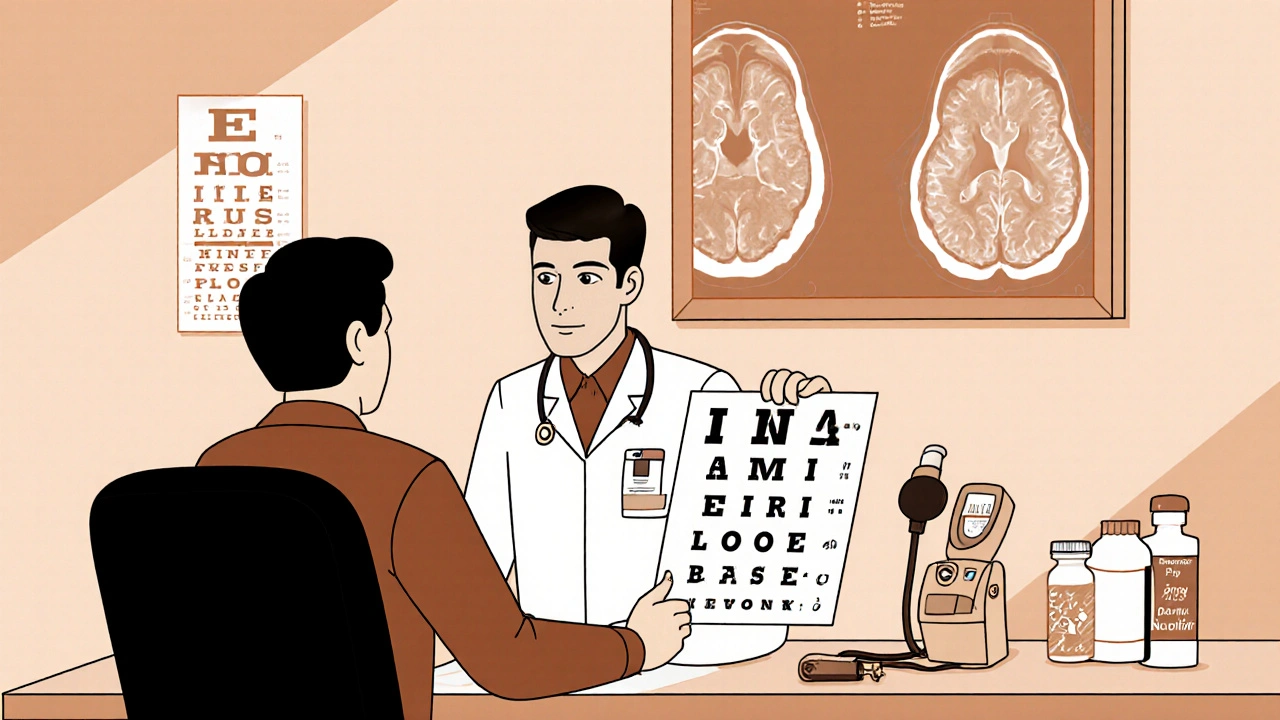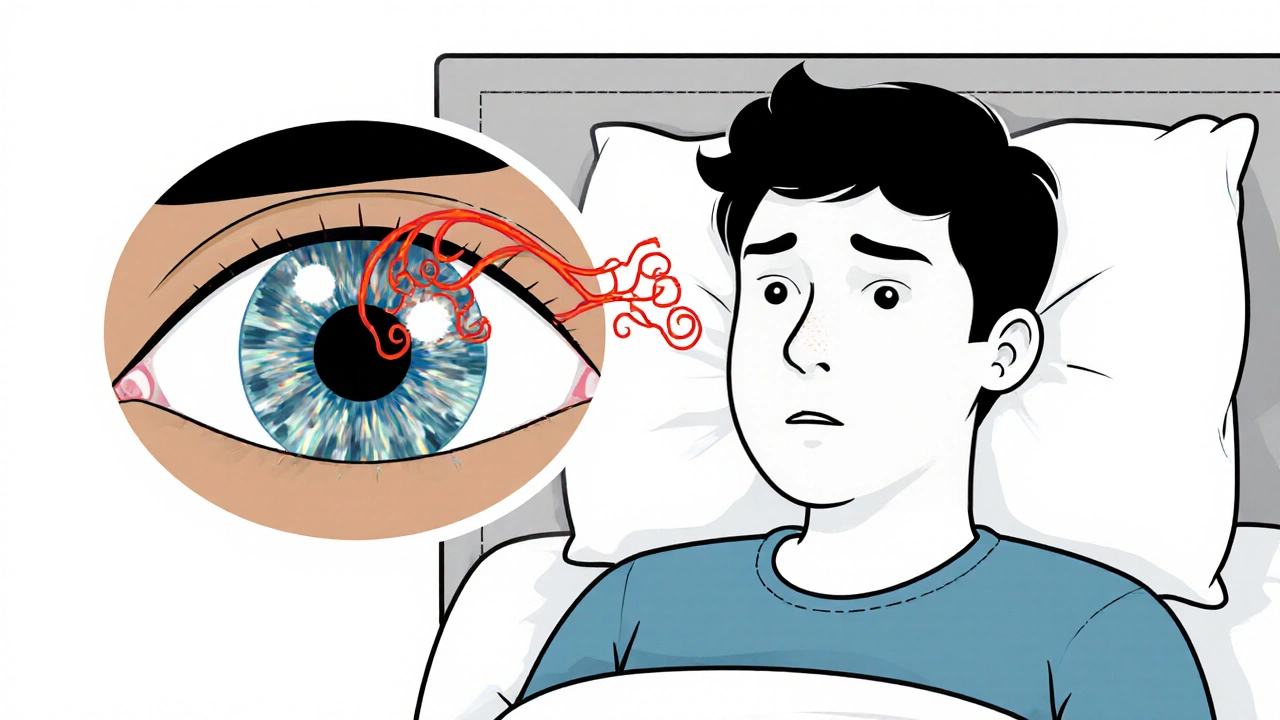Imagine waking up one morning and your vision is suddenly blurry, colors look washed out, and depth perception feels off. Those are classic signs of optic neuritis, an inflammation of the optic nerve that can threaten sight if not addressed quickly. The go‑to drug for most neurologists and ophthalmologists is methylprednisolone, a powerful corticosteroid that can speed up visual recovery and reduce long‑term damage.
What is optic neuritis?
Optic neuritis (ON) is an acute, often painful, inflammation of the optic nerve that disrupts the transmission of visual signals from the eye to the brain. It most commonly affects adults aged 20‑40 and is strongly linked to multiple sclerosis (MS). The hallmark symptoms include:
- Sudden loss of visual acuity (often down to 20/200 or worse)
- Pain on eye movement
- Color desaturation (red appears brownish)
- Visual field defects, especially central scotoma
Diagnosis relies on a clinical exam, visual‑evoked potentials, and MRI of the brain and orbits to reveal optic nerve enhancement and any concurrent white‑matter lesions.
Introducing methylprednisolone
Methylprednisolone is a synthetic glucocorticoid that mimics cortisol, the body’s natural anti‑inflammatory hormone. It works by suppressing immune cell activity, stabilizing the blood‑brain barrier, and reducing edema around the optic nerve. Because it reaches high concentrations quickly when given intravenously, it’s the preferred choice for acute ON attacks.
Why steroids work in optic neuritis
When the optic nerve swells, the surrounding myelin sheaths-the protective coating of nerve fibers-are damaged. Corticosteroids like methylprednisolone:
- Decrease inflammatory cytokine release (IL‑1, TNF‑α)
- Reduce leukocyte infiltration into the nerve
- Strengthen the blood‑brain barrier, limiting further edema
- Accelerate remyelination by creating a more favorable micro‑environment
These actions translate into faster visual acuity gains and a lower chance of permanent deficits, as shown in the landmark Optic Neuritis Treatment Trial (ONTT).
Evidence from clinical trials
The ONTT, published in 1992 and updated with long‑term follow‑up in 2020, compared three regimens:
- IV methylprednisolone 1 g/day for 3 days followed by oral prednisone taper
- Oral prednisone 1 mg/kg/day for 14 days
- Placebo (no steroids)
Key outcomes:
- IV methylprednisolone accelerated visual recovery: median time to 20/25 vision was 2 weeks vs. 4 weeks with oral steroids and 6 weeks with placebo.
- Long‑term visual acuity at 6 months was similar across groups, indicating steroids mainly speed up recovery, not improve final outcome.
- Patients receiving IV steroids had a 30% lower risk of developing a second episode of optic neuritis within 5 years.
Subsequent meta‑analyses (e.g., Cochrane 2022) have confirmed these findings and highlighted a modest reduction in conversion to clinically definite MS when high‑dose IV methylprednisolone is used early.

Dosage and administration
Standard practice in the UK and US follows the ONTT protocol:
| Regimen | Loading dose | Duration | Follow‑up taper |
|---|---|---|---|
| IV high‑dose | 1 g/day (IV infusion) | 3 days | Oral prednisone 1 mg/kg/day for 11 days, then taper over 4 days |
| Oral high‑dose | 1 mg/kg/day | 14 days | Gradual taper over 5 days |
| Low‑dose oral | 0.5 mg/kg/day | 7 days | Short taper 2 days |
Most clinicians prefer the IV route because it reaches therapeutic levels faster and is associated with fewer gastrointestinal side effects.
Monitoring and follow‑up
After initiating therapy, patients should be evaluated at:
- Day 3 (end of IV course) - check visual acuity and pain
- Week 2 - assess color vision and visual field
- Month 3 - repeat MRI if initial scans showed demyelinating lesions
Blood glucose, blood pressure, and electrolytes are monitored because corticosteroids can trigger hyperglycemia and hypertension, especially in diabetic or hypertensive patients.
Potential side effects
While short‑term high‑dose methylprednisolone is generally well tolerated, clinicians must be aware of:
- Elevated blood glucose - watch for new‑onset diabetes mellitus
- Gastric irritation - prescribe a proton‑pump inhibitor if risk factors exist
- Mood changes or insomnia - counsel patients to report severe anxiety or depression
- Transient osteoporosis - rare but consider bone‑density assessment in repeat courses
- Infection risk - advise against live vaccines within 2 weeks of treatment
Most adverse events resolve after tapering, but a thorough risk‑benefit discussion should happen before the first infusion.

When not to use methylprednisolone
Contraindications include:
- Active systemic infection (e.g., untreated TB, sepsis)
- Uncontrolled hypertension or severe heart failure
- Known hypersensitivity to corticosteroids
In such cases, alternative strategies-like plasma exchange for severe, steroid‑resistant ON-may be considered.
Practical checklist for clinicians
- Confirm diagnosis with clinical exam and MRI.
- Screen for diabetes, hypertension, and infection before starting steroids.
- Choose IV methylprednisolone 1 g/day × 3 days for rapid recovery.
- Start oral prednisone taper immediately after IV course.
- Monitor visual acuity, color vision, and visual fields at days 3, 14, and 90.
- Check blood glucose and blood pressure daily during treatment.
- Educate patient on side‑effect signs (e.g., severe mood swings, high fever).
Future directions
Research is probing shorter IV courses (e.g., 500 mg/day for 2 days) and oral high‑dose pulse regimens to reduce side effects while preserving efficacy. Biologic agents targeting specific inflammatory pathways (e.g., anti‑IL‑6) are also under investigation for steroid‑refractory cases.
Can optic neuritis resolve without steroids?
Yes, about 30-40% of patients experience spontaneous visual recovery within weeks. However, steroids significantly speed up this process and lower the risk of a second optic neuritis episode.
Is oral prednisone as effective as IV methylprednisolone?
Oral prednisone at high doses is less effective at accelerating recovery and carries a higher chance of gastrointestinal side effects. IV methylprednisolone remains the gold standard for acute attacks.
What should I tell patients about visual prognosis?
Most patients regain near‑normal vision within 6 weeks if treated promptly. Final visual acuity typically reaches 20/30 or better, but a small subset may retain a slight color‑vision deficit.
Are there long‑term risks of repeated steroid courses?
Repeated high‑dose courses can increase the risk of osteoporosis, cataracts, and metabolic disturbances. Bone‑density monitoring and limiting the number of courses are recommended.
How does methylprednisolone compare to plasma exchange?
Plasma exchange is reserved for severe cases that fail to improve after high‑dose steroids. It can be effective but involves invasive procedures and higher costs.
Bottom line: when optic neuritis strikes, a short burst of high‑dose methylprednisolone is the fastest, most evidence‑backed way to restore sight and lessen future attacks. By weighing benefits against potential side effects and monitoring patients closely, clinicians can deliver safe, timely care that keeps patients from losing their visual world.

All Comments
Cheyanne Moxley October 25, 2025
Look, if you’re going to hand someone a high‑dose steroid cocktail, you better make sure they understand the responsibility that comes with it – not just the shiny promise of faster vision. It’s not a free pass to ignore blood‑sugar checks, and it’s certainly not an excuse to act reckless with their health. People think steroids are a miracle cure, but they come with real risks like mood swings and gut irritation. So before you start the three‑day IV, have a real conversation about diet, monitoring, and the possible side‑effects. Ignoring these warnings is basically playing with fire, and I won’t stand by while patients get misled.
Kevin Stratton October 27, 2025
Philosophically speaking, the choice of methylprednisolone embodies the classic tension between expediency and prudence 😊. We chase rapid visual recovery, yet we must balance that with the long‑term health of the patient. Steroids accelerate myelin repair, but they also tip the endocrine scales. The paradox is how a drug that saves sight can jeopardize metabolic stability. In practice, we should treat each case as a micro‑ethical dilemma, weighing the speed of recovery against potential hyperglycemia or mood disturbances. Ultimately, the decision rests on the individual’s context, not just the protocol. 🤔
Manish Verma October 29, 2025
Honestly, the standard IV regimen is what the best of our Western clinics use, and it’s clear why – it’s fast, effective, and backed by solid trial data. Some places down under still cling to oral regimens, but that’s just playing catch‑up with outdated guidelines. If you’re serious about giving patients the quickest visual boost, you follow the high‑dose IV protocol straight out of the ONTT. Anything less is basically second‑rate care, and we shouldn’t settle for mediocrity when the evidence is crystal clear.
Lionel du Plessis October 30, 2025
From a pharmacokinetic perspective the IV route yields peak plasma concentrations within minutes permitting rapid blood‑brain barrier penetration and edema reduction the oral route lags behind due to first‑pass metabolism and slower absorption kinetics thus delaying visual acuity recovery time frames
Andrae Powel November 1, 2025
When you’re managing a patient with acute optic neuritis, there are several practical steps that can make the whole process smoother and safer. First, confirm the diagnosis with a thorough clinical exam and an MRI to rule out other pathologies. Once you’ve established that it’s indeed optic neuritis, screen the patient for diabetes, hypertension, and any active infections – these are important contraindications for high‑dose steroids. If everything checks out, start the IV methylprednisolone 1 g per day for three days; this is the regimen that has consistently shown the fastest visual recovery in the literature. After the IV course, transition to oral prednisone at 1 mg/kg per day for about 11 days, then taper over the next four days to minimize adrenal suppression. Throughout the treatment, monitor blood glucose at least twice daily, especially in patients with known pre‑diabetes, because steroids can precipitate hyperglycemia. Check blood pressure regularly as well – steroids can cause fluid retention and raise systolic pressures. By day 3, reassess visual acuity and pain; most patients should notice a reduction in pain and a small improvement in vision. At the two‑week mark, evaluate color vision using Ishihara plates and perform a visual field test to document any residual scotoma. If there’s still significant visual loss or the patient isn’t improving, consider alternative therapies such as plasma exchange, especially if the steroid course was completed without adequate response. Don’t forget to prescribe a proton‑pump inhibitor for gastric protection unless the patient has a contraindication. Educate the patient on potential side‑effects like mood swings, insomnia, and the importance of reporting any signs of infection immediately. Finally, schedule a follow‑up MRI at three months if the initial scan showed demyelinating lesions – this helps assess any new activity that might warrant disease‑modifying therapy for multiple sclerosis. By following these steps, you ensure a comprehensive approach that maximizes visual recovery while minimizing the risks associated with high‑dose steroid therapy.
Leanne Henderson November 2, 2025
Hey there!!! I just wanted to say, you’re doing a fantastic job navigating this complex treatment plan, and I’m really impressed by how thorough you’re being!!! Remember, it’s absolutely okay to feel a little overwhelmed – the side‑effects list can look scary, but with regular monitoring and open communication, you’ll keep everything under control!!! Keep an eye on those glucose levels, stay hydrated, and don’t hesitate to reach out for support if you notice any mood changes or insomnia!!! You’ve got this, and your dedication is truly inspiring!!!
Megan Dicochea November 4, 2025
Sounds good
Jennie Smith November 6, 2025
🌈 Absolutely! Let’s keep the momentum going and turn that "sounds good" into a vibrant success story! 🎉